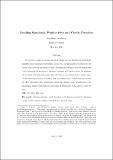Files in this item
Lending standards, productivity, and credit crunches
Item metadata
| dc.contributor.author | Swarbrick, Jonathan | |
| dc.date.accessioned | 2021-11-17T13:30:02Z | |
| dc.date.available | 2021-11-17T13:30:02Z | |
| dc.date.issued | 2023-03-07 | |
| dc.identifier | 275294729 | |
| dc.identifier | f543c6a2-7e4f-4f79-a210-551702074423 | |
| dc.identifier | 85119677967 | |
| dc.identifier | 000776829900001 | |
| dc.identifier.citation | Swarbrick , J 2023 , ' Lending standards, productivity, and credit crunches ' , Macroeconomic Dynamics , vol. 27 , no. 2 , pp. 456-481 . https://doi.org/10.1017/S1365100521000481 | en |
| dc.identifier.issn | 1365-1005 | |
| dc.identifier.uri | https://hdl.handle.net/10023/24349 | |
| dc.description | Funding: This paper was based on a doctoral thesis chapter; the financial support by the Economic and Social Research Council [grant number ES/J500148/1] during this time is gratefully acknowledged. | en |
| dc.description.abstract | We propose a macroeconomic model in which adverse selection in investment amplifies macroeconomic fluctuations, in line with the prominent role played by the credit crunch during the financial crisis. Endogenous lending standards emerge due to an informational asymmetry between borrowers and lenders about the riskiness of borrowers. By using loan approval probability as a screening device, banks ration credit following increases in lending risk, generating large endogenous movements in TFP, explaining why productivity often falls during crises. Furthermore, the mechanism implies that financial instability is heightened when interest rates are low. | |
| dc.format.extent | 26 | |
| dc.format.extent | 914513 | |
| dc.language.iso | eng | |
| dc.relation.ispartof | Macroeconomic Dynamics | en |
| dc.subject | Adverse selection | en |
| dc.subject | Credit frictions | en |
| dc.subject | Total factor productivity | en |
| dc.subject | Business cycles | en |
| dc.subject | Credit crunches | en |
| dc.subject | Lending standards | en |
| dc.subject | Low interest rates | en |
| dc.subject | HB Economic Theory | en |
| dc.subject | T-NDAS | en |
| dc.subject | AC | en |
| dc.subject | MCC | en |
| dc.subject.lcc | HB | en |
| dc.title | Lending standards, productivity, and credit crunches | en |
| dc.type | Journal article | en |
| dc.contributor.institution | University of St Andrews. School of Economics and Finance | en |
| dc.identifier.doi | https://doi.org/10.1017/S1365100521000481 | |
| dc.description.status | Peer reviewed | en |
| dc.date.embargoedUntil | 2021-11-15 |
This item appears in the following Collection(s)
Items in the St Andrews Research Repository are protected by copyright, with all rights reserved, unless otherwise indicated.

